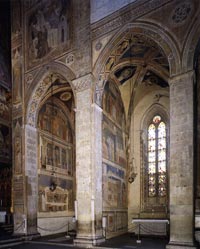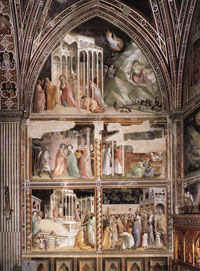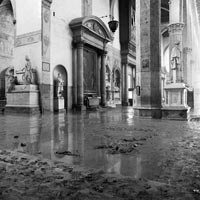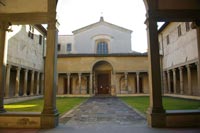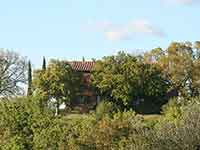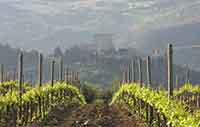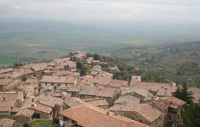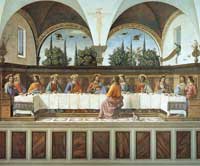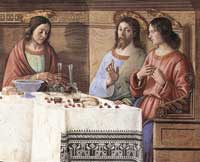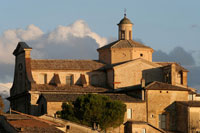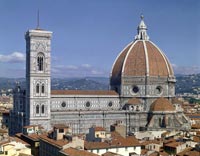 |
|
Taddeo Gaddi, Last Supper, Tree of Life and Four Miracle Scenes, 1360s, Fresco, 1120 x 1170 cm, Santa Croce, Florence |
|
Taddeo Gaddi | Frescoes in the Santa Croce, Florence |
| Taddeo Gaddi, one of Giotto's pupils painted the Baroncelli Chapel in the church of Santa Croce in Florence around 1328, brilliantly employing the technical achievements of his teacher. The frescoes represent Scenes from the Life of the Virgin.[1] For the end wall of their refectory the Franciscans commissioned Taddeo Gaddi to paint a Last Supper, an appropriate subject for the friars' dining hall. Above the last Supper Gaddi painted a Tree of Life, a devotional subject derived from the writings of the Franciscan St Bonaventure. To reinforce both its Franciscan and refectory context, the mystical tree is surrounded by a depiction of St Francis's stigmatization and the upper left and three holy events that take palace at meals, including the penitential image of Mary Magdalen washing the feet of Christ with her tears at the lower right.The frescoes were commissioned by the woman in the garments of a Franciscan tertiary kneeling at the foot of the cross, behind St Francis. At the right are the Priest at his Easter Meal Receiving Word of St Benedict's Hunger in the Wilderness, and the Magdalen Washing the Feet of Christ. At the left are the Stigmatisation of St Francis and St Louis of Toulouse Feeding the Poor and Sick of Toulouse. The frescoes were commissioned by the woman in the garments of a Franciscan tertiary kneeling at the foot of the cross, behind St Francis. At the right are the Priest at his Easter Meal Receiving Word of St Benedict's Hunger in the Wilderness, and the Magdalen Washing the Feet of Christ. At the left are the Stigmatisation of St Francis and St Louis of Toulouse Feeding the Poor and Sick of Toulouse. |
Basilica of Santa Croce, Florence |
| Santa Croce, rebuilt for the Franciscan order in 1294 by Arnolfo di Cambio, is the burial place for the great and good in Florence. Michelangelo is buried in Santa Croce, as are Rossini, Machiavelli, and the Pisan-born Galileo Galilei, who was tried by the Inquisition and was not allowed a Christian burial until 1737, 95 years after his death. There is also a memorial to Dante, but his sarcophagus is empty. Built in 1294, to a design by the great architect Arnolfo di Cambio, the Basilica has lived through seven centuries of history, augmenting its artistic heritage as a result of exceptional contributions, to the point of becoming one of the best-loved and most visited sites in Florence.[2] |
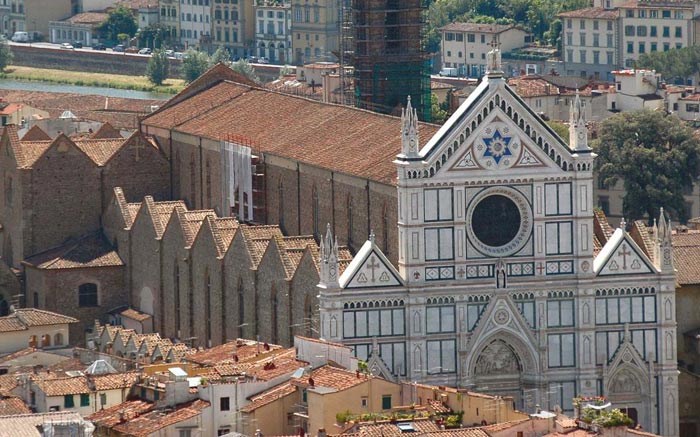 |
Firenze, Santa Croce |
| The Basilica di Santa Croce (Basilica of the Holy Cross) is situated on the Piazza di Santa Croce, about 800 metres south east of the Duomo. The site, when first chosen, was in marshland outside the city walls. |
| A fundamental feature of early Franciscan churches was the frescoed narration, in simple and clear terms, of the stories of Christ, of St Francis and of other saints. Several of the great Florentine families, including the Bardi, the Peruzzi, the Alberti, the Baroncelli and the Rinuccini, acquired the patronage of chapels in Santa Croce, thereby assuming the honour of decorating and furnishing them. Some of this 14th-century decoration has survived down to our own time, including that painted by the great Giotto, who frescoed the chapels of the banking families Bardi and Peruzzi (1320-25), respectively with Scenes from the life of St Francis and Scenes from the lives of St John the Baptist and St John the Evangelist. Giotto’s closest followers, Taddeo Gaddi, Bernardo Daddi and Maso di Banco painted frescoes in the chapels patronised by the Baroncelli, the Pulci and Berardi, and the Bardi di Vernio. From the mid-14th century the walls of the aisles and the Sacristy were frescoed by Andrea Orcagna, Giovanni da Milano, Niccolò di Pietro Gerini and Agnolo Gaddi. The fourteenth-century decoration was crowned by Agnolo Gaddi’s frescoes for the Chapel of the high altar, commissioned by the Alberti and illustrating the Story of the True Cross. Cappella Baroncelli The upper part of the fresco cycle depicts the scenes Joachim Driven from the Temple and the Annunciation to Joachim.
|
||
Last Supper in Santa Croce |
||
| Throughout the 14th century, the scene of the Last Supper was included in the grandiose cycles of frescoes which illustrated the Life and the Passion of Christ. During the 15th century, with invention of perspective, the Supper began to be represented independently on an entire wall. The "squared cut", already used by Giotto in the Scrovegni Chapel in Padua and then by Taddeo Gaddi in the Florentine Last Supper in Santa Croce, looks forward to the strongly compressed cubic space bathed in light of Andrea del Castagno’s monumental Supper in Santa Apollonia. The frescoed representations of the Last Supper by Domenico Ghirlandaio in Florence and in the Abbey at Passignano, which just predate Leonardo da Vinci’s Last Supper in Milan, are characterized by a descriptive naturalism. Leonardo’s exceptional masterpiece, on the other hand, served to glorify and spread the Florentine "fashion" in Northern Italy. In Florence, Franciabigio’s technique in his Cenacolo della Calza was highly influenced by Leonardo, while the colour and light of an Umbrian landscape characterize Perugino’s Cenacolo di Foligno. In the Last Supper at San Salvi, Andrea del Sarto surpasses the existing tradition imparting to his painting a luminosity worthy of Michelangelo and a psychological penetration that renders the figures full of "magnitude, majesty and infinite grace". |
||
 |
||
Taddeo Gaddi, Cenacolo, Basilica di Santa Croce, Firenze |
||
In about 1335 ca. Taddeo Gaddi (1300 c.a.-1366) in the ancient refectory of the convent of Santa Croce, created the Last Supper there. The fresco occupies a vast wall, depicting the Last Supper in the moment of the institution of the Eucharist and in the upper part there is the Tree of Life. The colors, dark and strong, are often interrupted by the degradation of the fresco which has requested restoration work. Around the poor table are seated Jesus and the Apostles, while Jude, who gives his back, seems to be stretching out a hand to the Redeemer that teaches, admonishes and consoles the Apostles, whose faces appear dark, sad, and preoccupied. |
||
| Agnolo Gaddi, presunto ritratto del padre negli affreschi della cappella maggiore di Santa Croce, Firenze. |  |
|||
|
||||
| Santacroceopera.it - Museo dell'Opera | www.santacroceopera.it The Museum was founded on the 2nd of November 1900 by Guido Carocci, who converted the Refectory, the Cenacolo, previously used as a storeroom for paintings and objets d’art, into a public exhibition hall. When a large restoration and redesigning project began on the church and cloisters in the mid-19th century, columns, capitals, family coats of arms, altars and other articles were all deposited in the old Refectory. This room was also used to store sculptures and fragments of frescos from Florence’s demolished historical centre, and some of these were kept permanently in Santa Croce. After its first inauguration, the Museum was filled with paintings, sculptures, bas-reliefs and frescos that gradually came to light during continuous restoration work on the Basilica. The new museum, managed by Luciano Berti, was inaugurated on the 26th of March 1959 with an exhibition of frescos from Orcagna, parts of the Church’s stained glass windows, Donatello’s statue of San Ludovico, various broken-off frescos and the Crucifix by Cimabue. The Museum was expanded in 1962: it was extended into the Refectory and the five adjacent rooms. The Museum was closed for a long time after the flood in 1966. It was rearranged and then reopened in 1975, and the impressive Crucifix by Cimabue was returned, a decade after the tragedy. |
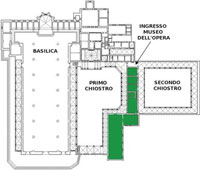 |
|||
| In 1966, the Arno River flooded much of Florence, including Santa Croce. The water entered the church bringing mud, pollution and heating oil. The damage to buildings and art treasures was severe, taking several decades to repair. Santa Croce was the first populated area to be overflowed by the flood. This area remained under the water longer compared to the others because it's lower with respect to the river. The Arno river completely filled the Cloister, it penetrated into the crypt, it disrupted the tombs of the Church. The works of removing the mud and the rubble took about two months. But the damages didn't finish here: the Franciscan fathers and those in charge of the Belle Arti saw the most devastating reality: the Crucifix by Cimabue, located in the Museum inside the big Franciscan refectory, was destroyed. Among great difficulties the heavy painted cross, drenched with water, was brought down and laid in a horizontal position. It took six hours to accomplish this difficult task, while the flakes of colour detached and fell in the mud. The mud was sieved and some fragments were recovered. The statue of Dante, now in front of the church, was still in the middle of the piazza in 1966. Museo dell'Opera di Santa Croce di Firenze Adjacent to the church is the convent complex with its two cloisters, the novices' quarters, the Chapter Room, better known as the Pazzi Chapel, and the refectory, which is now the premises of the Museum and houses famous works originating from the church and the cloisters. Address: Opera di Santa Croce, Piazza S. Croce, 16 Opening hours : Weekdays 9.30-17.30 Sundays and Sundays and holy days of obligation (Feast of the Epiphany, Feast of the Assumption, All Saints’ Day, Feast of the Immaculate Conception) 13.00-17.30 Easter Monday, 25 April, 1 May, 2 Jun 9.30-17.30 Last entrance 17.00 |
||||
| The Pazzi Chapel (Italian: Cappella dei Pazzi) is located in the "first cloister" of the Basilica di Santa Croce. Though funds for the chapel were assembled in 1429 by Andrea Pazzi, head of the Pazzi family, whose wealth was second only to the Medici, construction did not begin until about 1441. The chapel was completed in the 1460s, almost two decades after the death of the architect, Filippo Brunelleschi, himself. The main purpose of the building was obviously for the teaching of monks and other religious purposes. However, a suspected ulterior motive was for the Pazzi family to make a mark on the city of Florence Italy,to show their wealth and power in Renaissance era Italy. The fact that the city was at war with a neighboring city at the time and still acquired the funds to build this chapel showed the importance it had to the Pazzi family and the people of Florence. Was a work of Filippo Brunelleschi, it now seems that he most probably was responsible for the plan, which is based on simple geometrical forms, the square and the circle, but not for the building's execution and detailing. A façade that he had begun, and of which only the lower register can be seen, was partially obscured by the addition of a porch. The main inspiration for this piece was the Dominican monastery of Santa Maria Novella in Florence Italy. The size of the chapel was predetermined by existing walls, creating an unusual situation, however, where the space was not square as in the Old Sacristy, which was the model for this building, but rectangular and transept-like and thus in contradistinction to the square, axially-placed altar. Despite this, and its complex history, the building gives us insight into the ambitions of Renaissance architects in their struggle to bring coherence to the architectural language of columns, pilasters, arches and vaults. Between the pilasters in the transept there are tall, blank, round headed panels and, above them, roundels, common Renaissance decorative motifs. The architectural elements of the interior are all in pietra serena (English: "serene stone"). The building also used bearing masonry in its construction, which is mason units or concrete blocks with lime and man made adhesives to stick them together. As to the architect, scholars argue that it could have been either the work of Giuliano da Maiano or Michelozzo. The rondi of the seated Apostles are by Luca della Robbia, who also did the terracotta decorations in the cupola of the porch. It has been suggested that the roundels of the Evangelists may have been the work of Donatello. |
||||
|
||||
This page uses material from the Wikipedia articles Taddeo Gaddi, Baroncelli Chapel and Pazzi Chapel, published under the GNU Free Documentation License.
|
||||
|
||||
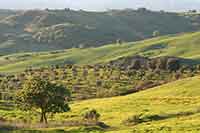 |
||||
Podere Santa Pia |
Castiglioncello Bandini |
Century-old olive trees, between Podere Santa Pia and Cinigiano |
||
| Monte Cucco wine region | Cipresses between Montalcino and Pienza | Montalcino | ||
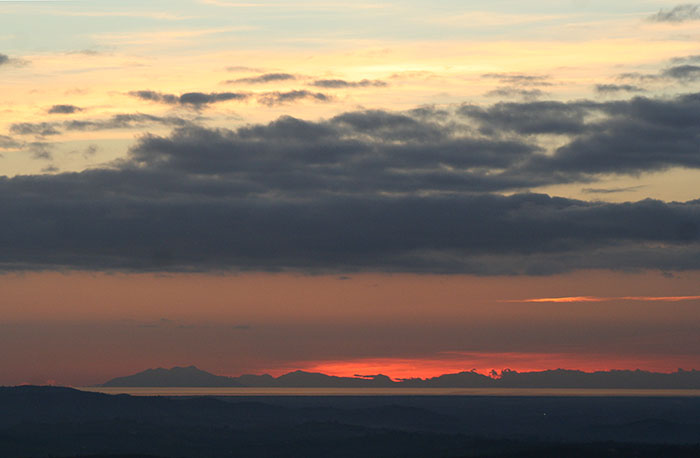 |
||||
Podere Santa Pia,tucked away in the Tuscan countryside, offers breathtaking views and sunsets |
||||
| Frescoes of the Last Supper in Florence |
||||
The refectories frescoed with the Last Supper are among the most interesting artistic monuments in Florence. As a result of the suppressions of religious orders which took place in the 18th and 19th century, a great many Florentine convents have been turned into museums. In them visitors can directly experience the art of the several excellent painters who in various periods have sought to express the beguiling spirituality of the Last Supper which Christ took with His disciples. Again and again in these refectories, which at one time were entered only by members of the religious orders, we are moved by the implicit tension between the concrete representation of domestic utensils and foodstuffs, and the high drama of the mystery of salvation proclaimed by Christ in the institution of the Eucharist.
|
|
|||
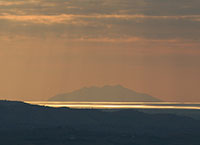 |
||||
Montefalco |
Florence, Duomo |
Sunsets in Tuscany |
||
Art in Tuscany | Last supper frescoes in Florence |
||||

